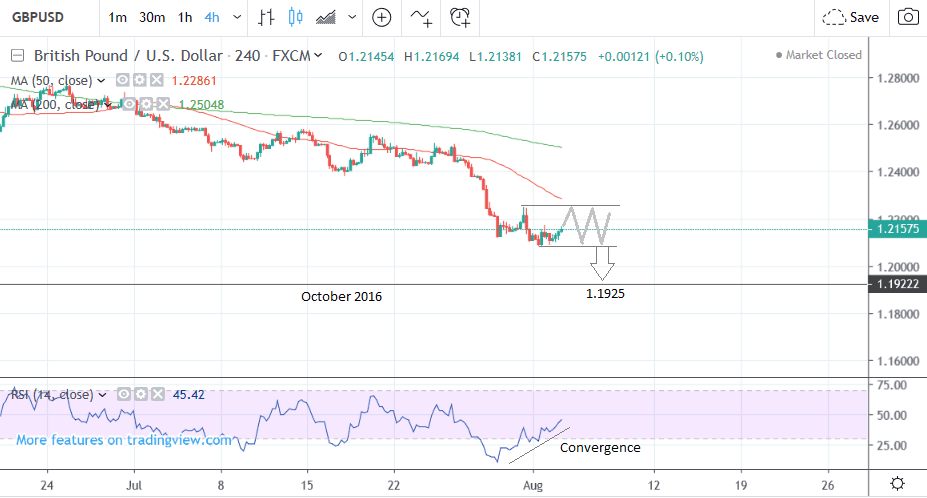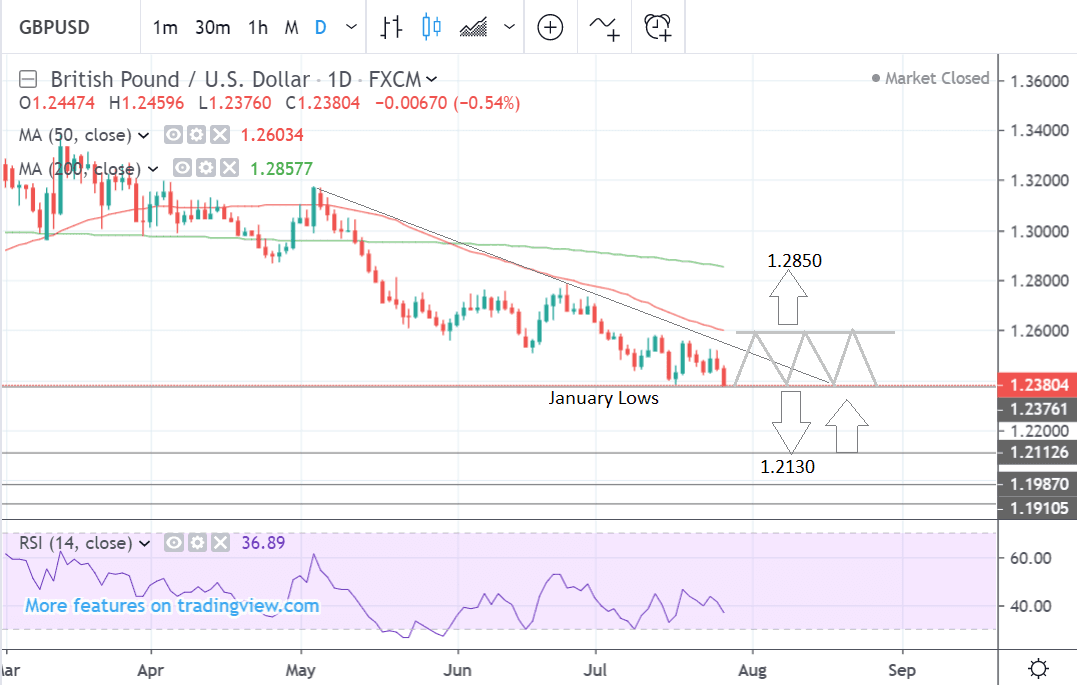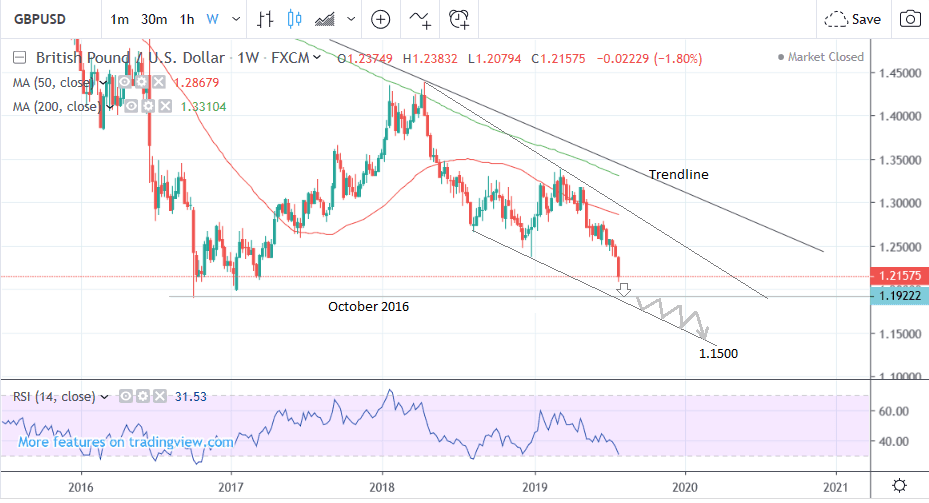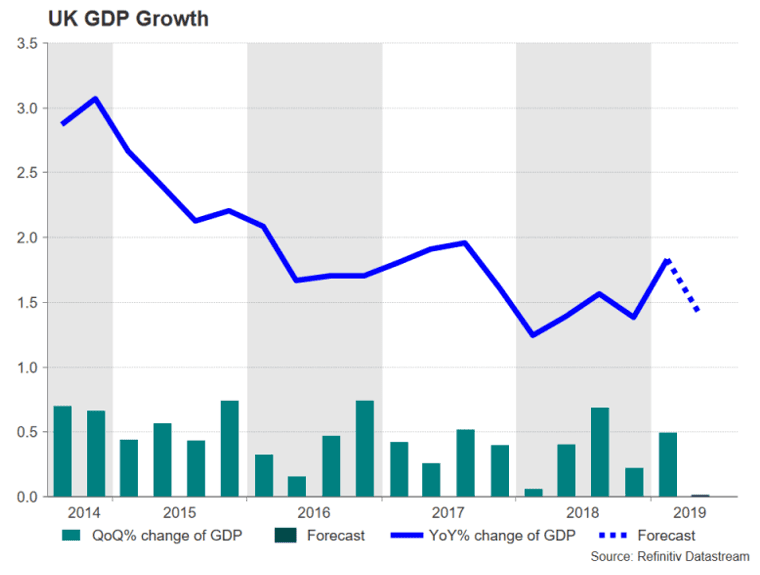Pound-to-Dollar Rate 5-Day Forecast: Downtrend to Probably Continue to Major October 2016 lows

Image © Adobe Images
- GBP/USD to decline to hard floor at 2016 lows
- Sideways trend also possible as momentum wanes
- Pound to be driven by GDP data; Dollar by non-manufacturing ISM
The Pound-to-Dollar exchange rate is trading at around 1.2157 at the time of writing after falling 1.8% in the week before. Studies of the charts suggest the pair will continue falling in line with the dominant downtrend.
The 4-hour chart - used to determine the short-term outlook, which includes the coming week or next 5 days - shows the pair in a steady downtrend which has slowed recently but not reversed.
A break below the 1.2079 August 1 lows would probably signal a continuation down to a target at the 1.1925 October 2016 lows.
The only sign that the downtrend may not extend is that the RSI momentum indicator is converging bullishly with price action which sometimes indicates a pull-back on the horizon. Convergence happens when prices make a new low but momentum does not follow. It is a sign of waning bearish momentum.
The RSI and the less steep descent in price both also suggests the trend may start going sideways instead, which is also possible in the short-term.
The daily chart - used to assess the trend over the medium-term, meaning the next week to month -shows the downtrend is likely to extend lower to the hard floor provided by October 2016 lows at 1.1925.
One signal the downtrend may be losing steam is the RSI, which is in the oversold zone below 30 and turning up. This suggests the downtrend may be overstretched and due a pull-back. There is a risk, therefore, the pair could go sideways after hitting the October 2016 lows.
Overall the downtrend is biased to extend in the end, however, dragging the exchange rate even lower, and a break below 1.1900 would lead to another step down to a target at 1.1750 in the medium-term.
The weekly chart - used to give an idea of the longer-term outlook, which includes the next few months - shows the pair in a downtrend since the start of 2018 which is forecast to continue.
A break below the October 2016 lows at 1.1925 would be a major turning point for the pair and suggest a much more bearish outlook.
Such a move could step decline lower to a downside target at 1.1500 eventually, based on using the lower borderline of the descending channel as a guide.
Time to move your money? Get 3-5% more currency than your bank would offer by using the services of foreign exchange specialists at RationalFX. A specialist broker can deliver you an exchange rate closer to the real market rate, thereby saving you substantial quantities of currency. Find out more here.
* Advertisement
The U.S. Dollar: What to Watch
The main release for the U.S. Dollar is likely to be the ISM non-manufacturing survey with producer prices on Friday also possibly impacting as well.
ISM non-manufacturing is forecast to recover to 55.5 in July from 55.1 in June, when it is released on Monday at 15.30 BST.
A result above 50 signals continued expansion in the sector. The non-manufacturing ISM has held up better than the manufacturing ISM during the recent slowdown. It could be said to have offset the damage from manufacturing and analysts will we watching whether it can continue providing a ‘crutch’ or whether it too is destined for a deeper decline.
“If you are looking for signs of a slowdown in the U.S. economy, look no further than the Institute for Supply Management’s purchasing manager indices. After topping out around 60 in the late summer/early fall of 2018, both the manufacturing and non-manufacturing PMIs have been on a steady downward descent. The manufacturing index has fallen farther than the non-manufacturing index, a trend that has played out elsewhere around the world of late, especially in Europe,” says American lender Wells Fargo, adding:
“From 2014-2016, a similar dynamic played out, as the U.S. economy as a whole slowed, but the slowdown was particularly concentrated in the manufacturing sector...Today, the non-manufacturing PMI sends a similar signal: economic growth is slowing, but the service sector likely remains strong enough to keep the overall economy afloat.”
Producer price inflation, also known as ‘factory gate' price inflation is forecast to rise by 0.2% in July from 0.1% previously when it is released at 15.00 on Friday.
A tame print could weigh on the Dollar since it may increase expectations of further interest rate cuts from the Federal Reserve (Fed).
The Fed cut rates by 0.25% in July as an ‘insurance policy’ against a downturn rather than the start of an easing cycle. If inflation pressures continue to fall, however, that might change and more cuts could be on their way.
It could be argued inflation starts at the factory gates from whence it fans out, so the readings can be a precursor of general inflation.
“Like other inflation measures, growth in the producer price index has slowed this year. On a year-over-year basis the PPI for final demand is up just 1.7%, the lowest reading since January 2017,” says Wells Fargo.” If PPI inflation were to slow further, it would likely reinforce markets’ views that this week’s rate cut by the Fed will not be a one-and-done move. Our forecast is for one more rate cut this year, and for inflation to eventually pick up around the end of the year.”
The Pound this Week: Brexit, GDP and PMI Data
Sterling retains a negative bias largely thanks to markets rapidly ramping up their expectations for a 'no deal' Brexit outcome on October 31 in response to the more robust approach adopted on the matter by the new administration of Boris Johnson.
Add to this growing expectations for a snap General Election before 2019 is out, and Sterling is seen to be facing an unprecedented cocktail of political uncertainties.
"The past week has witnessed some notable market movements, most visible of which has been the sharp fall in sterling which has seen the pound fall to levels last seen in 2017 against both the USD and the euro; GBP:USD hit a low of $1.2080 and GBP:EUR 1.0950 (€:£ 0.919). Growing concerns over the possibility of a no deal Brexit have been the predominant force behind the moves," says Ryan Djajasaputra, an analyst with Investec.
We are however wary that much of the news might already be 'in the price' of Sterling at this point, and wonder whether this theme can continue playing out unless some substantial political developments occur.
With much of the political class on their summer holidays, it could be that the issue dies down for some time.
However, noting the solid trend in Sterling we are wary of fighting the trend at this point.
"Looking to the forthcoming week there are no scheduled events which could shape Brexit sentiment given Parliament is in recess, but given the market sensitivity to Brexit we would be mindful of any comments which could come from government ministers or indeed other Tory MPs," says Djajasaputra.
The main economic release on the horizon for the Pound is GDP data for the second quarter of 2019.
The average forecast amongst economists is for growth to slow to 0.0% in Q2 from 0.5% in Q1, as Brexit risks weigh and based on already-released data for the quarter.
The 0.5% rise in Q1 was surprisingly strong but this was because businesses brought forward activity ahead of the original Brexit deadline on March 29 - this will not be the case for Q2, says American bank Wells Fargo.
Over the last 3 months leading indicators, industrial production and manufacturing production have also all softened, suggested growth was lacklustre in Q2.
The data is scheduled for release at 9.30 BST on Friday, August
“Growth in the British economy is forecast to have ground to a halt in the three months to June, slowing from the prior 0.5% rate. There’s a greater risk, however, of the data missing the forecasts than beating them given the heightened Brexit and political uncertainty during the period so a small contraction in Q2 wouldn’t be totally surprising,” says Raffi Boyadijian, an economist at FX broker XM.com.
If the data is worse-than-expected and shows a contraction into negative territory the Pound could decline, and vice-versa if it is better-than-expected.
The other main market-moving release is Services PMI out on Monday at 9.30.
This is important because services is the largest sector in the UK economy and PMI’s are leading indicators which means they tend to provide an early indication of the hard economic growth data which follows.
Currently, the average forecast for Services PMI is that it rises to 50.4 in July from 50.2 in the previous month of June.
A better-than-expected reading would help Sterling and vice-versa for a miss.
Time to move your money? Get 3-5% more currency than your bank would offer by using the services of foreign exchange specialists at RationalFX. A specialist broker can deliver you an exchange rate closer to the real market rate, thereby saving you substantial quantities of currency. Find out more here.
* Advertisement









